What
is the Rodster®?
© Copyright Caroselli.
No images or text located anywhere on this site may be reused
or republished without expressed written permission from Rodster,
Inc., d.b.a.: Caroselli Design. The Rodster Street Rod design
is protected by
U.S. Patent # D450,284.
"Rodster®" is a registered
trademark of Caroselli Design. |
AUTOWEEK
October 16, 2000
THE CAR: Brubaker Box
The original minivan
by John Matras
"We were chugging along looking for clients, trying to survive with a small design office, when it occurred to me that there were a hell of a lot of surfer kids getting around in old beat-up Volkswagen vans." That was Curtis Brubaker's epiphany. A trip to Newport Beach yielded a photo with eight or nine vans in it. "I thought, damn, there is something here."
For most that something would have been just a lot of battered old vans, but Curtis Brubaker isn't just anyone.
Like most young southern Californians in the early '60s, Brubaker had a passion for cars, adding a reputation for pinstriping and painting them. "It infuriated my dad because there were always car part patters silhouetted on the concrete."
A stint working on aircraft in the Navy was followed by the Art Center College of Design in Los Angeles--interrupted by a period helping Bill Lear design his executive jet--and a year-and-a-half at the advanced research group at General Motors, designing Cadillac interiors and small car concepts. "But I don't think I was cut out to be a corporate guy, so I came back to California and set up my own studio and actually did more work for General Motors, Volvo, Ford and the Japanese here than I did in Detroit."
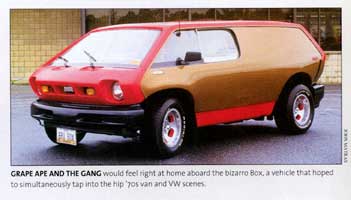
PHOTO CAPTION: GRAPE APE AND
THE GANG would feel right at home aboard the bizarro Box, a vehicle that
hoped to simultaneously tap into the hip '70s van and VW scenes.
It was then that the idea for an alternative vehicle developed in Brubaker's mind, combining his aircraft experience with elements of the economical and somewhat countercultural VW Beetle, the surfer vans and Bruce Meyer's fiberglass Manx dune buggy. The result was "A new kind of crossover vehicle."
"It was a one-box design. We did a mock-up right there in our little office and brought in investors and people got excited and we ultimately raised a small amount of funds," Brubaker recalls. With the $160,000 nest egg, the 31-year-old Brubaker intended to manufacture a kit car "to fit in the...business model that had been crudely established by others."
Like so many kit cars, it utilized the ubiquitous Beetle but had aspects of unibody construction, with 13 inner and outer fiberglass panels, including a floor panel, riveted and bonded together. Shock-absorbing bumpers were designed to look like curved wood. The fuel tank was mounted centrally and the spare mounted to absorb frontal crash energy. The stock VW front seats were retained, but a lounge-type seat was created for the rear of the vehicle for 53-inch-tall vanlets. A single sliding door on the right side was the only entrance, yielding more rigidity but also controversy from some corners.
Not, however, at the Los Angeles International Motorsports Show. The reaction to a prototype of the alliteratively named Brubaker Box convinced Brubaker that his decision to build completed vehicles was right. Negotiations with VW to acquire knock-down chassis, however, proved fruitless, with VW concerned about liability. As a result, Brubaker had to buy complete VWs from dealers, selling off unneeded parts. Awkward and labor-intensive, it was almost a wash financially, Brubaker says. He leased a 17,000-square-foot building in Los Angeles to assemble Boxes with plans for five per month, priced at $3,995, beginning in March 1972, and 400 per month by year's end. Alas, VW's recalcitrance made additional financing difficult. One of the investors was, as Brubaker says, "unruly." So the company filed for bankruptcy without making very many Boxes.
One of the investors tried to sell the Box as a kit, but the molds wound up being shuffled around the country as one entrepreneur after another tried to make a go of Brubaker's bold design. Most successful, perhaps, was Automecca, circa 1974, with its "Sports Van." It's still the Brubaker Box, though, to those who remember it.
To those who've never seen one, it's something special. Driving a Box owned by Dick Miller turned more heads than an Italian exotic. The front bumper isn't original, but out back the stock '72 VW four-banger behaves like any Beetle engine, and the Box, weighing about the same as a stock Beetle, accelerates similarly. The only really strange thing is the way-out-there windshield, not unlike the first Pontiac Trans Sports. The seating position, with its raised pedals, is simply peculiar.
Today the "minivan" is ubiquitous. In '72, the "mini-van," as one publication called it, was not. The Brubaker Box was the only one. Damn, there was something there.
Reprinted with permission from John Matras.
The Automecca Sports Van
(Or...the Brubaker is back?...)
by Phil Carpenter
I started to get back into the little kit van, climbing through the right side sliding door, when I noticed the guy approaching with his rumpled T-shirt, paunch, dark glasses and dopey grin. Oh no, I sighed to myself. Not again.
"Hey buddy...wait a minute. Hey, what the hell is this thing anyway?"
"It's called the Automecca Sports Van. Formerly known as the Brubaker after the original designer Curt Brubaker," I replied patiently.
"Oh yeah? Sonovagun. Shore is a weird-lookin' thing, ain't it? Where's it made, huh?"
"Automecca Industries, Chatsworth. They have a mailing address on Ventura Boulevard in Woodland Hills if you want to write for information." I turned and started to slide the door shut, which takes a pretty healthy right arm pulling it one-handed from inside. I hoped Clem Clod would take the hint and write Automecca rather than delay me further, but the odds on his being able to write were rather dim. He also refused to be discouraged that easily.
"So hey, tell me buddy, how much does a thing like this cost?" He moved closer, sticking his head in the doorway to observe the yellow Naugahyde and fabric upholstery and wilting my permanent press Arrow shirt with his breath.
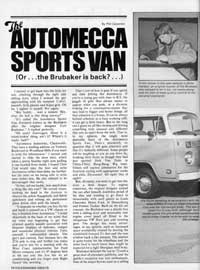
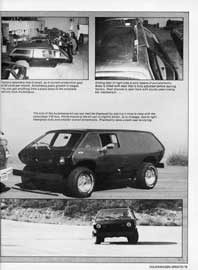
"It depends on whether you buy the kit and build it yourself on a VW chassis or buy it finished from Automecca." I noted objectively in the back of my mind that my voice was beginning to get that strained quality usually associated with frequent displays of rudeness, temper and occasional physical violence. Calm yourself, I commanded silently. The guy's just curious. Just because he's the 27th jerk to stop and bother you today and you're late for a meeting with the West Coast representative for Ford Motor company and it's 97 degrees here in the sun and this box has no air conditioning and you forgot your Right Guard this morning...
That's sort of how it goes if you spend any time driving the Automecca. If you're a young guy with time to B.S. the gaggle of girls that always seems to appear when you park, or a divorcee looking for a conversation-starter that may lead to bigger and better things, all that attention is a bonus. If you're always behind schedule as a busy working stiff, it can get a little heavy. But in the long run I guess we all like owning and driving something truly unusual and different that sets us apart from the mob. That is, in my opinion, the single most desirable facet of the Automecca Sports Van. There's absolutely no question that it will gain attention and that it's radically different. Some people will be laughing at you as you drive by, honking their horns as though they had just spotted Dick Van Dyke in Chitty-Chitty Bang-Bang. Big treat. Others will express admiration for the futuristic styling with appropriate ooohs and ahhs. (Dynomite! All right! Out of sight!)
But, of course, you want to get into the story a little deeper. To regress somewhat, the original designer named the van after himself, doubtless proud of his idea and wanting to go down in immortality with such greats as Louis Chevrolet, Henry Ford, Al Deusenburg and Forrest Tucker. Built on the kit car concept, the Brubaker was a plastic box with a sliding door and removable rear engine cover panel all fitted to the ubiquitous VW floor pan and running gear. The design has many advantages, in my opinion, such as increased space availability created by moving the windshield forward 2 1/2 feet and the rear window back a like amount. The interior is quite roomy for the wheelbase and the noise level is much lower than might be expected for a light fiberglass shell body.
Brubaker debuted the van in '72 with a great deal of attendant publicity, and the public's reception was very enthusiastic. One of the major factors used in selling point was that the economy normally associated with the VW engine would be retained in this new kit van, not to mention good handling characteristics. (This can be a mixed blessing in my opinion, depending upon which year V-dub you use as a base.) The future looked bright after several major magazines ran articles publicizing the Brubaker but, alas, the best laid plans...
To make a long story short, production never fulfilled the promise elicited and the company folded. But one of the investors, Mike Hansen, recently became the prime mover in giving new life to the van by forming a corporation known as Automecca. They have a small factory in Chatsworth, California where the vans and bodies are prepared for sale, and a business office at 22462 Ventura Blvd., Woodland Hills, CA 91364. (213) 340-3538. Hansen has set more realistic goals, he says, for this trip around. These include limiting production to around 20 units per month, most of them kit bodies for customers to build onto their own VW chassis and running gear. The only way you can get a completely built sports van is to arrange your own deal with Mike, although he says the pricing varies for each unit due to customers wishing special paints, stereo systems, interiors, etc.
The full price list is included in this article, which you not consider as gospel. My experience with previous kit car articles ahs led me to make disclaimers on any pricing of components, since the costs of all petroleum-based products often fluctuate quite rapidly. As far as being able to say how much work and time is involved in mounting the kit body to your VW, there's no accurate method of determining this. Each individual van will be built slightly different by the owner, of course; your own competence and ingenuity plays a major role in how the project comes out. We've seen some other kit cars finished very professionally by those who took their time and bought quality pieces to make a highly finished product...and we've seen some kit cars that could be used for Mattel commercials. (The one where the kid runs it across the floor into Daddy's chair and it flies into 12 pieces.)
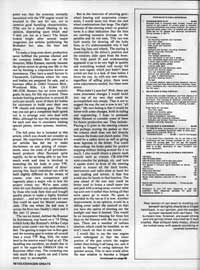
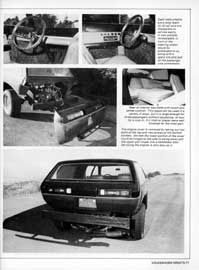
The van we tested, dubbed the Roamer by Automecca, was based on a '74 Thing (which looks like Rommel's Afrika Corps desert scout cars)--not the best choice, I feel. The gearing is super-low in first gear and the running gear is noisier all around than a stock VW Bug. Still, the noise level in the interior wasn't bad at all. The handling was excellent, no doubt due in part to the super-fat GR60x14 tires on Keystone offset rims. The cornering was very much like a sports car and J-turns were easy to accomplish.
But in the interests of steering gear, wheel bearing and suspension components, I would never run front tire and wheel combinations that large. The slight shimmy of the steering wheel on gradual turns is a clear indication that the tires are exerting excessive leverage on the spindles and tire rod ends. This van was built mostly for showing off the body lines, so it's understandable why it had those big tires and wheels. The seating is comfortable in the driver's position and the windows slide open from the front. The body panel fit and workmanship appeared to us to be very high in quality and everything worked well except for one turn signal, which just hadn't been sorted out due to a lack of time before I drove the van. As with any new vehicle, regardless of selling price, there were some adjustments needed, but these were minor.
What didn't I care for? Well, there are some structural changes I would build into one of my own that could be accomplished very simply. That is not to suggest the way the van is now is not "all right." My own feeling is that it would be better with some changes, both in styling and engineering. I hope to persuade Mike Hansen to consider some of them for future production use. They include: Placing a U-joint in the steering column and perhaps moving the pedals so that the column shaft does not fall directly between the brake and clutch pedal. This would be a safety move as well as giving more legroom to the driver. You could then enlarge the brake pedal for quicker stopping without feeling around for it as much. I also would obtain a plastic dash console such as contain CB/AM/FM mini-consoles for pickups, etc. and turn it upside down in front of the steering wheel to mount all the dash knobs, instruments and radio close at hand for easy reading and service. A fuse box would also be handy in that location. The area ahead of the rear seat could be better used to house a small spare tire and jack with a swing-away covered table top unit over it rather than letting all that extra space go to waste. No spare is provided in the van as it is now. Another improvement, in my opinion, would be a sliding cover under the sunroof so that you have the option of shutting out the sunlight and heat if desired. This would be an inexpensive blessing for those hot days on the freeway with the sun in your eyes. There are a number of various interiors which could be installed, so we won't touch on that to any extent.
I would like to see the rear engine cover redesigned so that the lower portion of the pan covers the engine rather than letting it all hang out, and it could be hinged to swing sideways for quicker access. This in turn would allow the rear window to become a hinged hatchback door for access to the interior. As it is now, the van can only be entered from the right side door, so carrying anything is a real problem if it's bulky. Also, in the event of an accident where the right door is jammed, you'd be trapped with no other practical exit. As far as styling, a new front piece could be added with a lower gravel pan extending down around the front torsion tubes so the axle and all that ugly stuff is covered as well. The wooden bumpers look too homemade for my taste. A set of chrome nerfs of tubular steel would be preferable. Also, the front end shell could be easily reworked to take a set of rectangular headlights, the current trend, thereby making a futuristic van look even more modern. A porthole-type window in the rear quarter-panels would aid visibility, let in more light and could be vented for air circulation. A set of Ford van side mirrors would also aid in rear viewing as they stick up higher. Our right side mirror was worthless on the test van. A new paint scheme also would help with some custom striping, etc. That's my idea of a super-trick little mini-van that would be great fun to drive handle well, get terrific mileage and best of all...would provide you with a never-ending stream of characters coming up and asking, "Hey buddy...what the hell is this thing, anyway?"
PHOTO CAPTIONS:
Prime mover in the new venture is Mike Hansen, an original back of the Brubaker who refused to let it die. He works alongside his men to keep quality control to his personal standards.
We found handling to be excellent with the wide GR60x14 tires on offset Keystone rims and the lightweight body. The van is great fun to play with, although more conservative tire and wheel combinations would make it better to drive and increase the mileage.
Factory assembly line is small, as is current production goal of 20 units per month. Automecca plans growth in stages. You can get anything from a basic body to the complete vehicle from Automecca.
Sliding door in right side is only means of exit and entry. Body is fitted with door that is fully adjusted before leaving factory. Roof channel is seen here with sturdy steel sliding bar mechanism.
The size of the Automecca kit van can best be displayed by placing it nose to nose with the ubiquitous VW bus. Performance of the kit van is slightly better, as is mileage, due to light fiberglass body and smaller overall dimensions. Practicality takes a back seat to styling.
Rear section of van down to molding just beneath taillights should be hinged hatchback, in our opinion, and the wooden bumper replaced with nerf bars. The bumpers now, however, are super-strong and are spring/shock mounted for 5 mph crashes. Rear exhaust looks messy, should be tucked away with special plumbing or covered somehow.
Dash instruments are a long reach for driver and are impossible to service easily. A new console immediately in front of the steering wheel would be preferable to us, along with a spare tire and jack on the passenger side somewhere.
Rear of interior was done with couch and settee cushion. This space can be used in a variety of ways, but it is large enough for three passengers without squeezing, or four for a love-in. Kit interior pieces were well finished for the most part.
The engine cover is removed by taking out two bolts at the top and two screws at the bottom corners. We feel the lower portion of the cover could be hinged at the side to swing away and the upper part made into a hatchback door. Servicing the engine is very easy as is.
Magazines articles on the BRUBAKER BOX Sports Van:
(1) Car and Driver, March 1972, "The Best Thing that’s Ever Happened to a Beetle." By Gordon Jennings (Cover Story)
(2) Dune Buggies and Hot VWs, Summer 1972. "Fancy, Functional - The BRUBAKER. It could put the FUN in Functional." By Chuck Nerpel
(3) Road Test, September 1974,Volume 10 - Number 9, "The Return of the BRUBAKER Sports Van - A Mini-Van Designed for Many Uses." By Walt Woron
(4) Four Wheeler, April 1972, Volume 9, Number 4, "BRUBAKER: A Micro-Mini Van for Street/Off Road Use." By Walt Woron
(5) Volkswagen Greats, August 1974, "The BRUBAKER Returns! The Return of the BRUBAKER BOX." By Wally Wyss
(6) Van World, March 1977, "Mini-Van of The Future is Here Today (The Box Comes Back)" By Chris Hosford
(7) Volkswagen Greats, April 1977, "The AutoMecca Sports Van (Or...the BRUBAKER is back?...)" By Phil Carpenter
(8) Dune Buggies and Hot VWs, April 1977, Volume 10 - Number 4, "AutoMecca Sports Van" By Scott McMillan
(9) KIT CAR, The Car Builder’s Authority, November 1999. "BRUBAKER BOX (The Box Was Tops)" By Harold Pace (Kit Carchives)
(10) AutoWeek, October 16, 2000, "THE CAR: Brubaker Box. The original minivan." By John Matras
